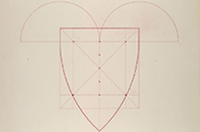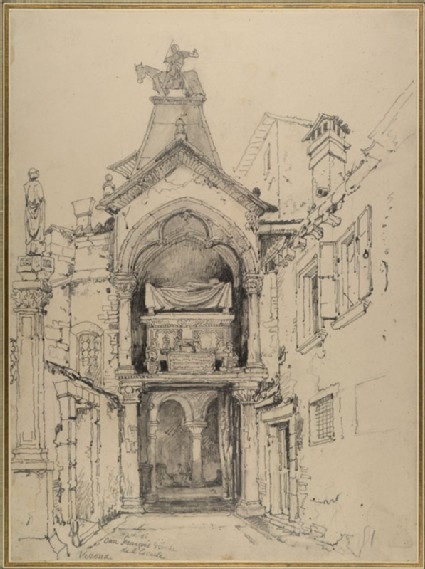Ruskin's Rudimentary series, 3rd ed. (1872)
Items marked 'M' are drawings "by my own Hand" (by Ruskin), P are photographs, E engravings and A by Ruskin's Assistant, Arthur Burgess.

Ruskin's Catalogues: 1 object
Show search help- Reference URL
Actions
The Tomb of Cangrande I della Scala in Verona Samuel Prout
-
Ruskin text
R|25} View taken of the tomb of the best knight of Italy by the modern English enlightened mind, educated in legitimate contempt of the dark ages. S. Prout. -
Curator’s description:
Description
The drawing depicts the tomb of Can Grande della Scala, lord of Verona, who died on 22 June 1329. The tomb is placed above the north door on the outside of the church of Santa Maria Antica in Verona, supported by two columns. The drawing focusses on the tomb itself, framed by a line of houses on the right (west) and the iron fence that surrounds the tomb of Mastino II della Scala on the left (right). The tomb takes the form of a sarcophagus carrying a recumbent figure of Can Grande, set beneath an arched canopy which rests upon two columns. Above is a tall pinnacle, topped by a figure of Can Grande in full armour, on horseback.
Prout was in Verona in 1824, although he may also have visited the city when he was in Italy in 1827.
The drawing was first recorded in the collection in 1872, as no. 25 in the Rudimentary Series, a position it has continued to occupy. It was the final item in case 1, which was labelled 'Heraldry' by Ruskin. However, he was somewhat ambivalent as to its qualities, entitling the drawing "View taken of the tomb of the best knight of Italy, by the modern English enlightened mind, educated in legitimate contempt of the dark ages", and noting in his 1878 reorganisation of the series that it showed 'the result of total want of education on an entirely strong and original artistic mind. Had Prout been trained in a fine school he could have done things as beautiful as the monument itself'.
Ruskin made much of the tomb of Cangrande, and there are several other representations of it in the collection: Reference Series no. 57 is a drawing of the tomb by Ruskin, focussing on the sarcophagus, canopy and upper levels. Reference Series no. 63 contained a series of small studies by Ruskin of details of the tomb's upper levels. Educational Series no. 76 is a drawing by Ruskin, focussing on the sarcophagus and its canopy. Educational Series no. 77 is a similar drawing, focussing more closely on the sarcophagus and effigy. Educational Series no. 78 was a drawing by Ruskin of part of the sarcophagus's cornice. Educational Series no. 79 contained a drawing by Ruskin of the head of one of the shield-bearing dogs which supports the sarcophagus. Rudimentary Series no. 24 was a photograph of the tomb.
In "The Stones of Venice", Ruskin describes the tomb as embodying 'the consummate form of the Gothic tomb', which also managed to balance Can Grande's pride with his honour, in part because it appears more as a decoration of the church's portal than as a monument in its own right (vol. III, ch. ii, §§ 53-4 = XI.87-8). In his lecture on Verona and its rivers, he described Can Grande as 'a good knight and true, living, I think, the busiest and the brightest life that you can find in the annals of chivalry' (§ 22 = XIX.441-442).
Ruskin gave a detailed description of his reasons for admiring Prout's work in the "Notes on Prout and Hunt" which he composed to accompany an exhibition of the artists' work at the Fine Art Society in 1879-1880. He stated that Prout possessed 'a genius as earnest as it was humble, doing work not in its essence romantic at all; but, on the contrary, the only quite useful, faithful, and evermore serviceable work that the [Old Water-Colour] Society - by hand of any of its members - had ever done, or could ever, in that phase of its existence, do' (§ 29 = XIV.391).
Prout's work delighted in the dilapidated and the old, and in portraying it rather than trying to produce a narrative or evoke sentiment; it was 'painting - as mere painting' (§ 27 = XIV.389), focussing on the art of depiction in its own right (cf. The Eagle's Nest, § 87 = XXII.185; and Samuel Prout, § 11 = XII.313-314, where the much younger Ruskin praised Prout's depictions of the picturesque; likewise in The Elements of Drawing, § 257 = XV.221-222). Prout's work was, importantly unaffected. Like Turner, Bewick and William Henry Hunt, Prout could draw the poor, but not the rich - because he seldom drew active figures. 'He understood, and we do not, the meaning of the word "quiet"' (§ 42 = XIV.402).
Ruskin also praised Prout's abilities as a consummate draughtsman: 'Prout is not a colourist, nor in any extended or complete sense of the word a painter. He is essentially a draughtsman with the lead pencil .... And the chief art-virtue of the pieces here exhibited is the intellectual abstraction which represents many features of things with a few lines.' (§ 31 = XIV.392.) In his 1872 lecture on contentment in science in art, Ruskin noted that this 'imperfect' style was ideally suited to Prout's dilapidated subject-matter: a more refined execution would only have exposed the subjects' imperfections (The Eagle's Nest, § 87 = XXII.185-186).
But Prout was also 'the only one of our artists who entirely shared Turner's sense of magnitude, as the sign of past human effort or of natural force' (§ 39 = XIV.399) - a quality sadly lacking in contemporary artists and their audiences. This was a sign of Prout's character: 'The quiet and calm feeling of reverence for this kind of power, and the accurate habit of rendering it ... are always connected, so far as I have observed, with some parallel justice in the estimate of spiritual order and power in human life and its laws' (§ 41 = XIV.401). Related to this was Prout’s 'greatness in composition', his ability to arrange his works according to 'an order only the more elevated because unobtrusive' (Samuel Prout, § 10 = XII.312-313); The Two Paths, § 60 = XVI.302) - and so Ruskin referred to his writings frequently in "The Elements of Drawing"
Prout was also significant for having recorded many buildings before they were pulled down or destroyed by restoration (Samuel Prout, §§ 7 & 12 = XII.310-311 & 314-315; cf. Pre-Raphaelitism, § 26 = XII.362) and The Two Paths, § 60 = XVI.301): 'The works of Prout [...] will become to memorials the most precious of the things that have been; to their technical value, however great, will be added the far higher interest of faithful and fond records of a strange and unreturning era of history' (Samuel Prout, § 12 = XII.314-315).
-
Details
- Artist/maker
-
Samuel Prout (1783 - 1852)
- Object type
- drawing
- Material and technique
- graphite and wash on off-white wove paper
- Dimensions
- 356 x 264 mm
- Associated place
-
- Europe › Italy › Veneto (Venetia) › Verona › Verona › Chiesa di Santa Maria Antica › Tomb of Mastino II della Scala › Tomb of Mastino II della Scala (subject)
- Europe › Italy › Veneto (Venetia) › Verona › Verona › Chiesa di Santa Maria Antica › Chiesa di Santa Maria Antica (subject)
- Europe › Italy › Veneto (Venetia) › Verona › Verona › Chiesa di Santa Maria Antica › Tomb of Cangrande I della Scala › Tomb of Cangrande I della Scala (subject)
- Inscription
- bottom left in black chalk: arci di | Can Francois Grande ['Francois' struck through] | de l'Escaile | Verona
- Provenance
-
Presented by John Ruskin to the Ruskin Drawing School (University of Oxford), 1875; transferred from the Ruskin Drawing School to the Ashmolean Museum, c.1949.
- No. of items
- 1
- Accession no.
- WA.RS.RUD.025
-
Subject terms allocated by curators:
Subjects
-
References in which this object is cited include:
References
Ruskin, John, The Ruskin Art Collection at Oxford: Catalogue of the Rudimentary Series, in the Arrangement of 1873, ed. Robert Hewison (London: Lion and Unicorn Press, 1984), cat. Rudimentary no. 25, RUD.025
Ruskin, John, Instructions in Practice of Elementary Drawing, Arranged with Reference to the First Series of Examples in the Drawings Schools of the University of Oxford (n.p., [1872]), cat. Rudimentary no. 25
Ruskin, John, Instructions in the Preliminary Exercises Arranged for the Lower Drawing-School (London: Smith, Elder, 1872), cat. Rudimentary no. 25
Ruskin, John, Instructions in the Preliminary Exercise Arranged For the Lower Drawing-School (London: Spottiswoode, 1873), cat. Rudimentary no. 25
Ruskin, John, ‘Rudimentary Series 1878’, 1878, Oxford, Oxford University Archives, cat. Rudimentary no. 25
Ruskin, John, ‘The Ruskin Art Collection at Oxford: Catalogues, Notes and Instructions’, Edward T. Cook and Alexander Wedderburn, eds, The Works of John Ruskin: Library Edition, 39 (London: George Allen, 1903-1912), 21, cat. Rudimentary no. 25
Location
-
- Western Art Print Room
Position in Ruskin’s Collection
Ruskin's Catalogues
-
Ruskin's Rudimentary series, 3rd ed. (1872)
R|25} View taken of the tomb of the best knight of Italy by the modern English enlightened mind, educated in legitimate contempt of the dark ages. S. Prout. -
Ruskin's Rudimentary series 4th ed. (1872)
R|25} View taken of the tomb of the best knight of Italy by the modern English enlightened mind, educated in legitimate contempt of the dark ages. S. Prout. -
Ruskin's Rudimentary series, 5th ed. (1873)
R|25} View taken of the tomb of the best knight of Italy by the modern English enlightened mind, educated in contempt of the dark ages. S. Prout. -
Ruskin's revision to the Rudimentary series (1878)
remains 25.The comparison of this with No 24, will always be in the highest degree instructive; 25, showing the result of total want of education on an entirely strong and original artistic mind. Had Prout been trained in a fine school he could have done things as beautiful as the monument itself; being left without instruction, this is all he could come to. But this is far better than he could have done had he been ill-instructed. The power of this is true and natural as far as it goes.





